The author of this blog on April 21, 2016 appeared on Beyond 50 Radio, based in Portland, Oregon. Here is the YouTube link, in the event anyone wants to hear the interview: https://www.youtube.com/watch?v=9geh6fL2ALE.
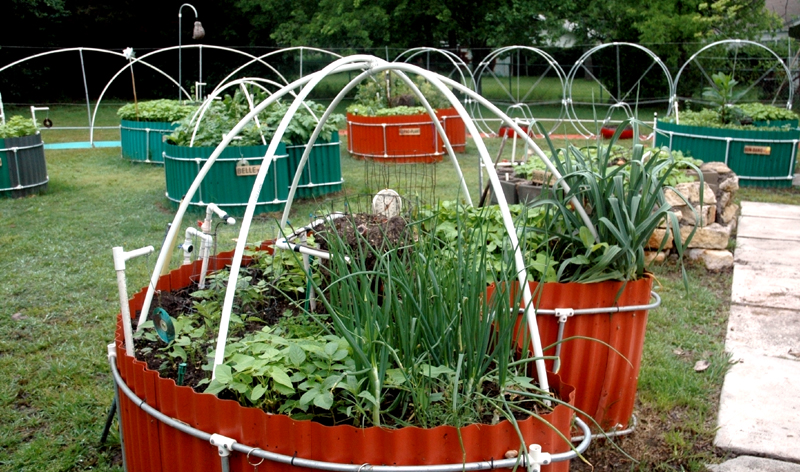 We are in mid-April and the plants at Keyhole Farm are looking good. Most were planted about a month ago. Herewith are a few random photos of where we are now. Just click on the images to enlarge.
We are in mid-April and the plants at Keyhole Farm are looking good. Most were planted about a month ago. Herewith are a few random photos of where we are now. Just click on the images to enlarge.
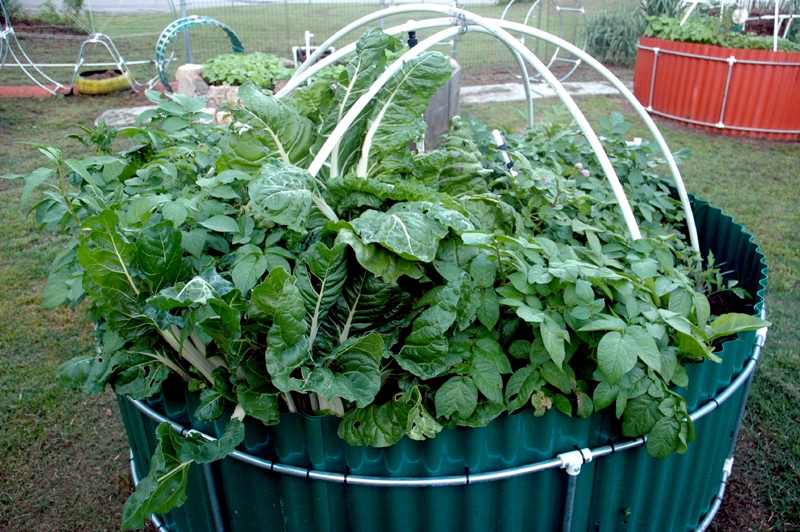 You might notice in the background some contraptions that resemble wagon wheels. These are actually keyhole frames — part of the kits we sell — that we turned vertically on their sides to form a partial fence to keep deer out. In the past we utilized CDs dangling from outside the keyhole gardens and also ran fishing line to form an area border with sound-making weights attached to one end so that when deer tried to cross, contact with the fishing line would cause the weights to move off a bucket and onto the ground to create an abrupt noise to scare deer away. It worked fairly well, but we wanted to do something a little different (experimentally) this year.
You might notice in the background some contraptions that resemble wagon wheels. These are actually keyhole frames — part of the kits we sell — that we turned vertically on their sides to form a partial fence to keep deer out. In the past we utilized CDs dangling from outside the keyhole gardens and also ran fishing line to form an area border with sound-making weights attached to one end so that when deer tried to cross, contact with the fishing line would cause the weights to move off a bucket and onto the ground to create an abrupt noise to scare deer away. It worked fairly well, but we wanted to do something a little different (experimentally) this year.
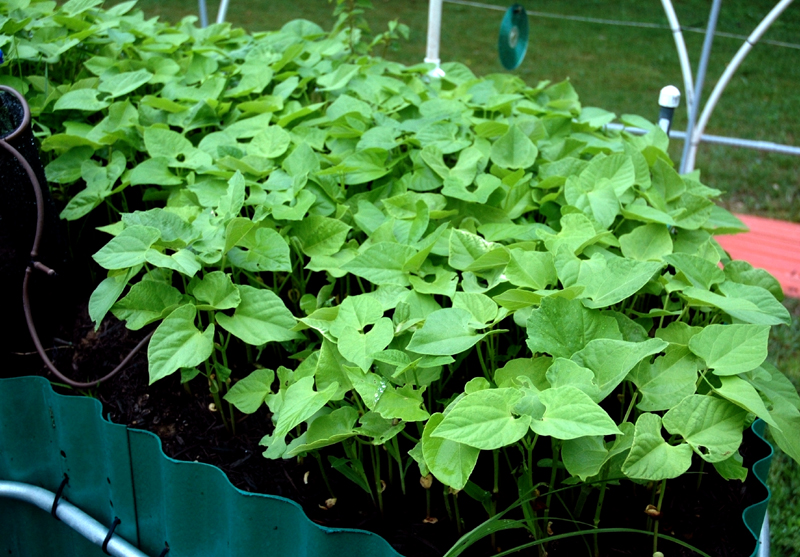 Here, we placed the frames vertically on the ground with the cut-out wedge portion on the bottom. Below the wedge we placed some pick-up tires (with the tops cut out and holes on the underside to allow water to escape). Then we filled the tires with material (mainly soil) and planted flowers (like morning glories and zinnias) in them. We ran strings up and out from the top of the wedge to the tee-post parts of the frame to create trellises for the vines to inhabit. On the back side of the frames we attached deer netting (barely visible). The frames are six feet tall, so it should work well.
Here, we placed the frames vertically on the ground with the cut-out wedge portion on the bottom. Below the wedge we placed some pick-up tires (with the tops cut out and holes on the underside to allow water to escape). Then we filled the tires with material (mainly soil) and planted flowers (like morning glories and zinnias) in them. We ran strings up and out from the top of the wedge to the tee-post parts of the frame to create trellises for the vines to inhabit. On the back side of the frames we attached deer netting (barely visible). The frames are six feet tall, so it should work well.
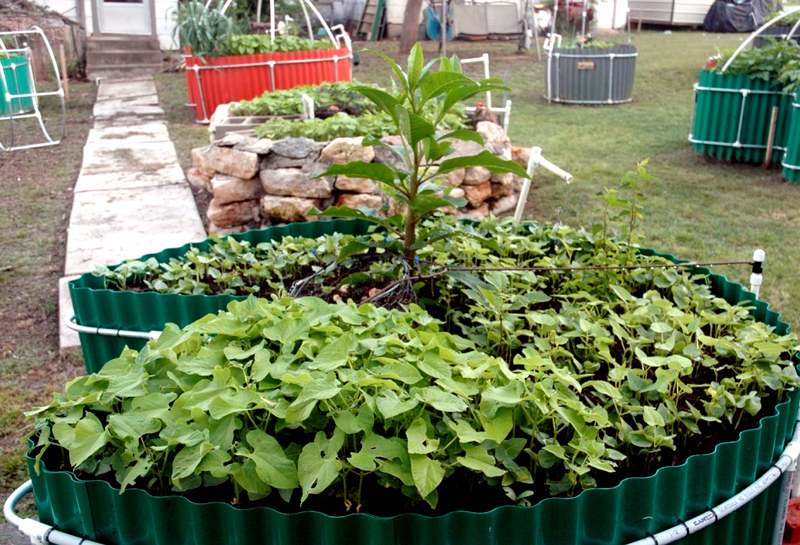 Part of this vision is to have the Keyhole Farm area better defined, with big circles containing brilliant blue morning glories.
Part of this vision is to have the Keyhole Farm area better defined, with big circles containing brilliant blue morning glories.
This season’s plantings include (among others) beans, peas, onions, turnips, zucchini and crook-neck squash, pumpkins, several varieties of tomatoes, corn, chard, lettuce, cantaloupe, watermelons, and potatoes. I always go heavy on beans, since I like them so much, but we also planted quite a few potatoes. The purple flowers are already showing up on them.
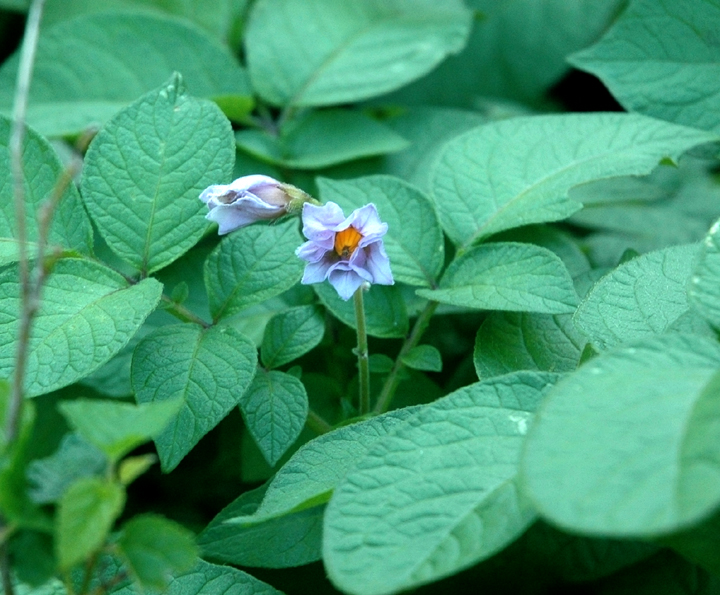 So far this spring, Keyhole Farm has broken all records on manufacturing kits and shipping them throughout the United States. One good thing about keyholes is that you can start your own farm any time of the year, so it is never too late to get started. Several educational facilities have bought kits this year to teach kids about raising crops, which, to me, is extremely important. It is a skill that will stay with them always, a real-world experience that teaches the beauty of Mother Nature’s universe. A lot of creativity goes into this type of gardening. It can also help in the development of academic prowess, from geography to mathematics, from meteorological awareness to science, from soil development to caring for plants — agriculture at its best.
So far this spring, Keyhole Farm has broken all records on manufacturing kits and shipping them throughout the United States. One good thing about keyholes is that you can start your own farm any time of the year, so it is never too late to get started. Several educational facilities have bought kits this year to teach kids about raising crops, which, to me, is extremely important. It is a skill that will stay with them always, a real-world experience that teaches the beauty of Mother Nature’s universe. A lot of creativity goes into this type of gardening. It can also help in the development of academic prowess, from geography to mathematics, from meteorological awareness to science, from soil development to caring for plants — agriculture at its best.
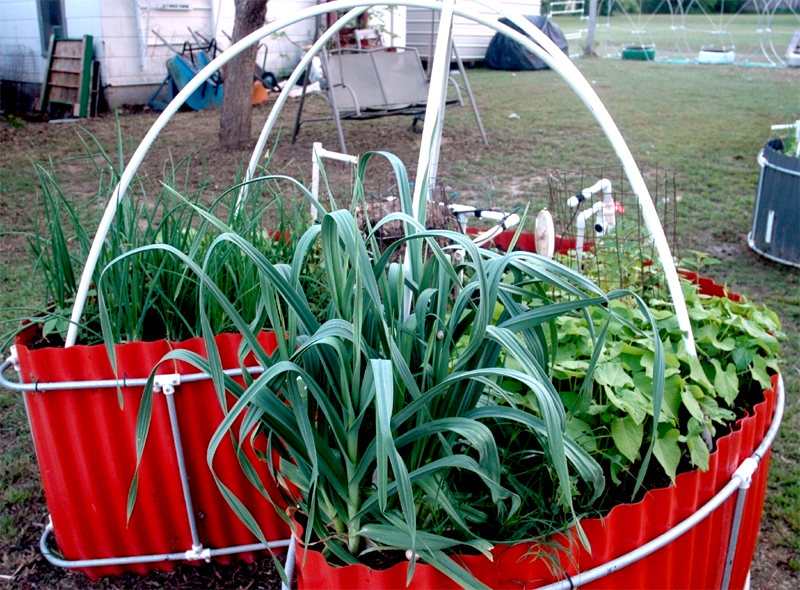 During a segment of history when the family farm has been vanishing, this is an opportunity to rekindle some of those experiences and learn the challenges of having your own backyard family farm, with a gardening system that produces excellent crops that can be harvested at their peak, when the nutritional and taste values are beyond compare.
During a segment of history when the family farm has been vanishing, this is an opportunity to rekindle some of those experiences and learn the challenges of having your own backyard family farm, with a gardening system that produces excellent crops that can be harvested at their peak, when the nutritional and taste values are beyond compare.
 We are at the stage at Keyhole Farm when as you step outside in the morning, the growth of the plants day to day is easily noted, one of my favorite experiences. Too, it is enjoyable to track the habits of butterflies and bees as they go about their chores and routines. Backyard farms not only produce excellent food, but they are also somewhat like sanctuaries, or islands of beauty that feast on recycling. They are a quiet place to get back to nature while accumulating a resounding sense of accomplishment at the same time.
We are at the stage at Keyhole Farm when as you step outside in the morning, the growth of the plants day to day is easily noted, one of my favorite experiences. Too, it is enjoyable to track the habits of butterflies and bees as they go about their chores and routines. Backyard farms not only produce excellent food, but they are also somewhat like sanctuaries, or islands of beauty that feast on recycling. They are a quiet place to get back to nature while accumulating a resounding sense of accomplishment at the same time.
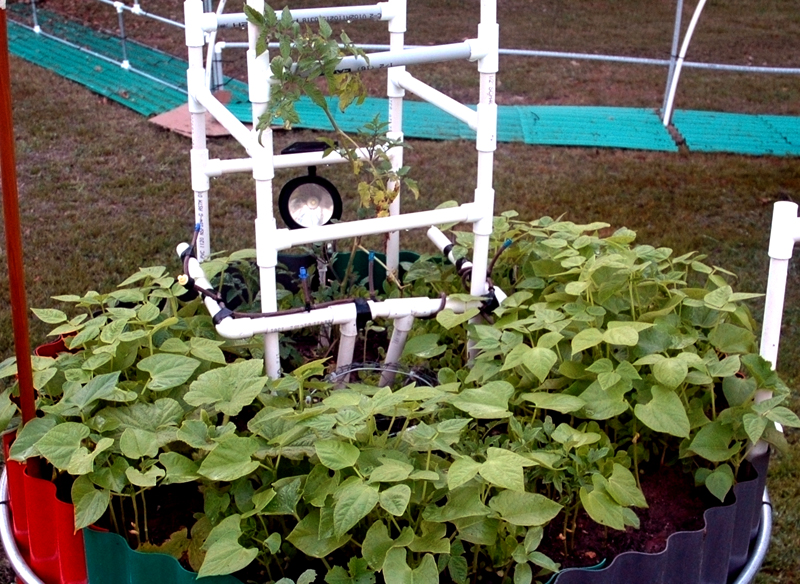 Some of the advantages of keyhole gardening include the conservation of water, compact planting, easiness on the back (less bending over), minimal (if any) weeding, the ability to feed the circular-shaped raised-bed gardens in its internal recycling basket with food scraps to provide natural nutrients for the crops, harvesting at the peak for exponentially more nutritious and tasty crops, control of the soil by utilizing cardboard, twigs, and leaves as part of the ingredients that enhance the growing capabilities of plants, and, of course, the experience itself.
Some of the advantages of keyhole gardening include the conservation of water, compact planting, easiness on the back (less bending over), minimal (if any) weeding, the ability to feed the circular-shaped raised-bed gardens in its internal recycling basket with food scraps to provide natural nutrients for the crops, harvesting at the peak for exponentially more nutritious and tasty crops, control of the soil by utilizing cardboard, twigs, and leaves as part of the ingredients that enhance the growing capabilities of plants, and, of course, the experience itself.
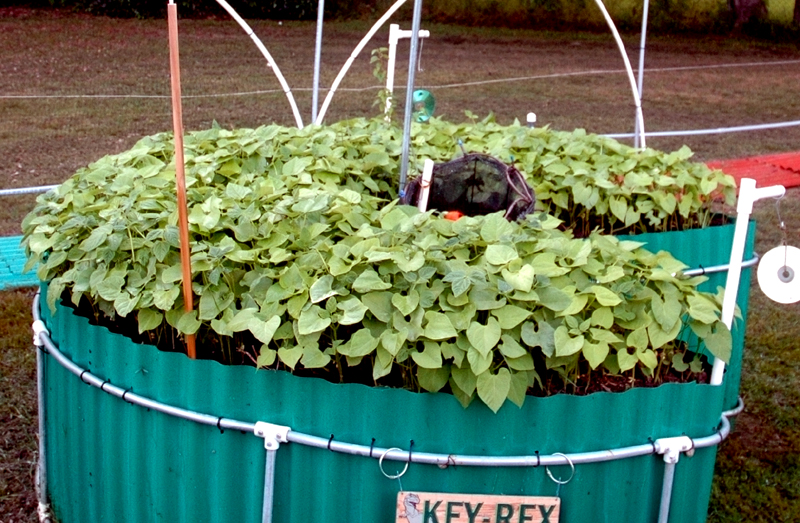 One experiment we have not tried and that we are eager to delve into is putting a few of our keyholes in a third-world country where a lack of food is a major issue. Perhaps instead of just providing a bowl of rice, we could set up a keyhole farm system whereby they could constantly raise some of their own crops.
One experiment we have not tried and that we are eager to delve into is putting a few of our keyholes in a third-world country where a lack of food is a major issue. Perhaps instead of just providing a bowl of rice, we could set up a keyhole farm system whereby they could constantly raise some of their own crops.
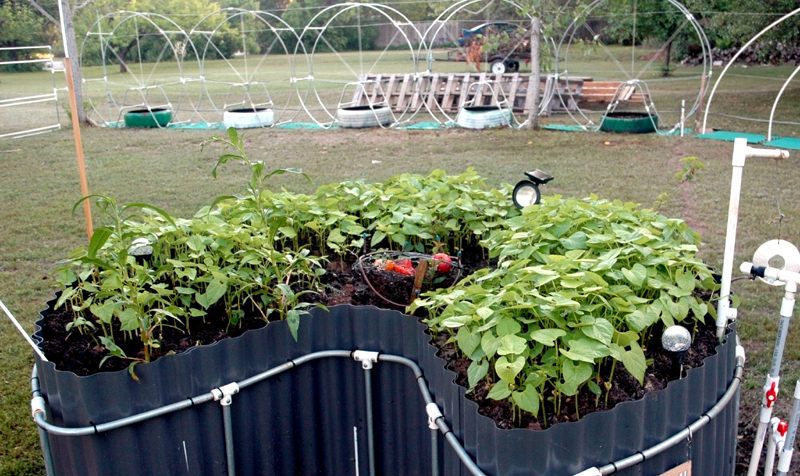 If anyone has any ideas how this could be developed, I would appreciate your getting in touch with me. Personally, I view the possibilities of striking down world hunger in this manner as enormous, maybe something that the younger generations who learn the techniques of keyholing could extend throughout the world as years go by.
If anyone has any ideas how this could be developed, I would appreciate your getting in touch with me. Personally, I view the possibilities of striking down world hunger in this manner as enormous, maybe something that the younger generations who learn the techniques of keyholing could extend throughout the world as years go by.
I consider keyhole gardening as the perfect system. Why not share it?